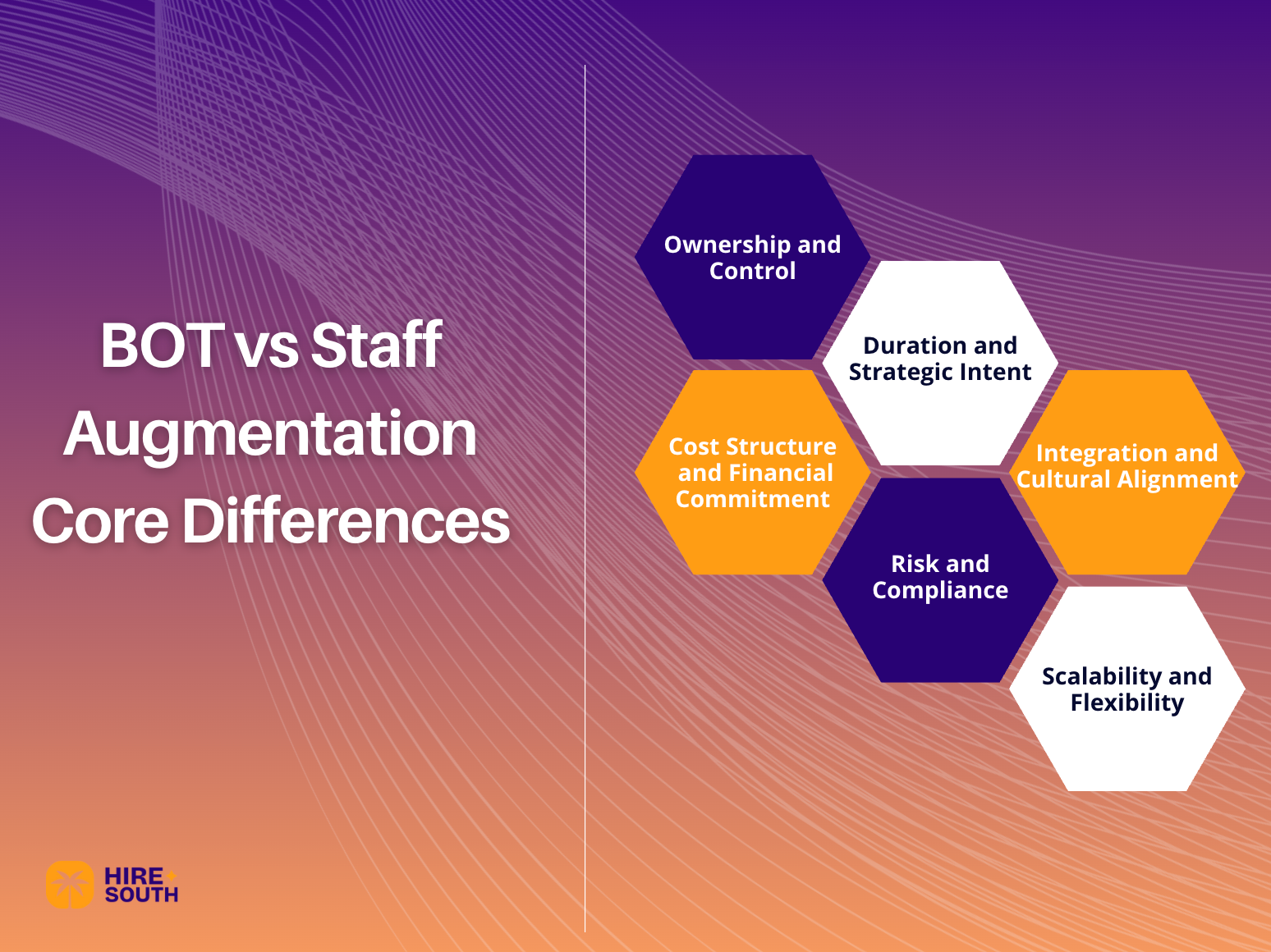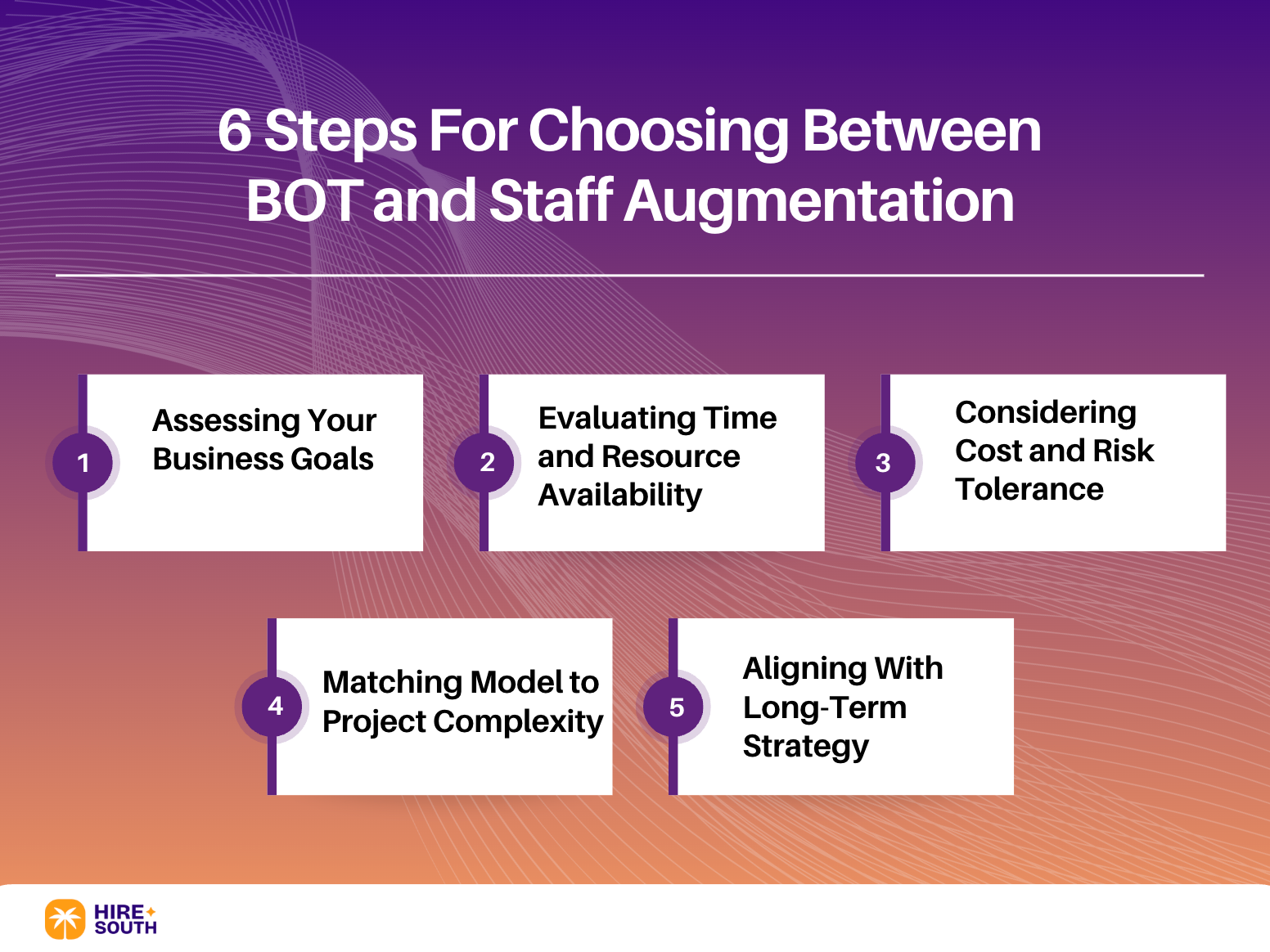If you’re familiar with hiring remote talent, you know that choosing the right outsourcing model can make or break the entire operation. Two of the most widely discussed frameworks today are the Build-Operate-Transfer (BOT) model and staff augmentation, both effective yet designed for very different needs.
If you’re scaling your software team, expanding into new markets, or trying to optimize development costs, understanding the difference between BOT and staff augmentation is key. Each model impacts your control, cost, risk, and scalability in distinct ways.
According to Deloitte’s Global Outsourcing Survey, 70% of businesses now use outsourcing primarily to cut costs. Still, the most successful ones also use it to access specialized talent and improve business agility. That’s exactly where BOT and staff augmentation come in.
In this article, you’ll explore what each model is, how they work, their pros and cons, and how to decide which one fits your organization best. Keep reading to learn if you should choose BOT Latin America or traditional staff augmentation!
What Does BOT Stand For in Business?
In business, BOT stands for Build-Operate-Transfer, a model often used in technology, infrastructure, and outsourcing. It’s a structured partnership where a service provider builds a dedicated operation for a client, manages it for a set period, and then transfers full ownership once it’s stable and efficient.
Think of it as a temporary collaboration with a clear handover plan. The vendor handles setup, staffing, and daily operations during the “operate” phase. Once performance targets are met, the client takes over a fully functioning, legally compliant team or facility, without the risks of building it from scratch.
The BOT model is especially common in IT and software development because it helps companies scale in new regions quickly. According to Statista, over 60% of global companies outsource IT services to reduce operational complexity and gain faster market access. BOT structures make this possible by combining speed, control, and risk management under one framework.
For example, a U.S. tech company might use a BOT setup to establish a nearshore development center in Latin America. The vendor builds the team, operates it efficiently, and eventually transfers it once processes and culture align with the parent company.
What Is Staff Augmentation?
Staff augmentation is a flexible outsourcing strategy that allows you to add external professionals to your existing in-house team for specific roles, projects, or timeframes. Instead of hiring full-time employees, you bring in qualified specialists, often from nearshore or offshore markets, to fill skill gaps or meet short-term project demands.
This model has become especially relevant in the global IT and software sectors. Gartner reported in 2024 that 78% of organizations use contingent or contract talent as part of their workforce strategy, highlighting how staff augmentation supports agility and rapid adaptation to changing project scopes.
Unlike project-based outsourcing, staff augmentation gives you more control. You decide who joins your team, how they work, and for how long. It’s also faster than recruiting full-time staff, which can take months in competitive tech markets. According to SHRM data, the average time to fill a technical role in the U.S. is 44 days, while staff augmentation partners can often supply talent within a week.
For businesses managing multiple projects or fluctuating workloads, staff augmentation helps maintain momentum. It reduces hiring risk, minimizes training time, and keeps your core team focused on strategic objectives, all while maintaining full visibility over daily operations.
The Core Differences Between BOT vs Staff Augmentation

Ownership and Control.
In a BOT model, the ultimate goal is full ownership. The service provider builds and manages the operation only temporarily before transferring all assets, teams, infrastructure, and processes to you. Once transferred, you hold complete control.
In staff augmentation, control remains operational rather than structural. You manage the external professionals as part of your team, but they remain employees of the vendor. There’s no transfer of ownership, only access to skilled labor.
This distinction matters if your long-term plan includes establishing a permanent offshore or nearshore presence. BOT supports that goal, while staff augmentation is designed for short- to mid-term workforce flexibility.
Cost Structure and Financial Commitment.
The BOT model usually involves a higher upfront investment but delivers long-term savings once the transfer occurs. You pay for setup, operations, and eventual ownership transition.
Staff augmentation, on the other hand, is cost-efficient at the start since you only pay hourly or monthly rates for talent. However, long-term dependence on external staff can become more expensive if projects extend indefinitely.
According to Deloitte’s Global Outsourcing Survey, 59% of companies choose outsourcing primarily for cost efficiency, but those using BOT models often report 20–30% savings in the long run compared to recurring augmentation costs.
Risk and Compliance.
With BOT, risk management is shared. The vendor handles local compliance, infrastructure, and legal requirements during the “operate” phase. Once the transfer happens, you inherit a legally sound and compliant entity.
In staff augmentation, risk remains minimal but focused. Since you’re not setting up a new entity, the vendor retains responsibility for employment contracts and compliance. However, you’re accountable for how the augmented staff performs within your operations.
If your organization operates in heavily regulated sectors like fintech or healthcare, BOT provides a stronger compliance foundation through formalized legal ownership and governance.
Scalability and Flexibility.
BOT models are built for strategic scaling. They allow you to ramp up operations, stabilize them, and eventually internalize the entire setup. It’s a long-term play designed for market expansion or global delivery centers.
Staff augmentation is more tactically flexible. You can scale your team up or down quickly depending on project requirements. This makes it ideal for agile development cycles or temporary resource gaps.
Data from McKinsey shows that companies using hybrid models, combining BOT for core operations and staff augmentation for short-term needs, achieve 32% faster project delivery and better talent utilization overall.
Duration and Strategic Intent.
The BOT model is inherently long-term, typically spanning 2 to 5 years before full transfer. It’s best suited for businesses looking to build sustainable offshore operations or gain a permanent foothold in new regions.
Staff augmentation is short- to mid-term. It supports ongoing projects, seasonal demands, or skill-specific initiatives without structural commitments. Once the project ends, contracts conclude easily.
Your choice depends on whether you want to own an operation or simply access additional expertise. BOT offers the path to build an asset; staff augmentation provides immediate workforce elasticity.
Integration and Cultural Alignment.
BOT engagements emphasize deep cultural and operational integration from the beginning, ensuring that once transferred, the team already mirrors your company’s values and workflows.
Staff augmentation prioritizes fast deployment over full integration. While augmented staff collaborate closely, their connection to your company culture tends to remain limited to the project’s context.
Comparing the BOT Model and Staff Augmentation in Practice
When you compare the BOT model and staff augmentation in practice, the real differences appear in how each model operates on a day-to-day basis, how teams are managed, how projects evolve, and how business outcomes are measured. These practical implications go beyond theory and directly affect your project speed, talent retention, and long-term scalability.
Project Setup and Onboarding:
In a BOT arrangement, setup involves building from the ground up, hiring local talent, establishing legal entities, and implementing operational systems. This initial phase can take several months, but results in a dedicated and self-sufficient team.
Staff augmentation, in contrast, focuses on rapid onboarding. Since augmented professionals are already vetted and trained by the vendor, you can integrate them into your workflow almost immediately. According to Harvard Business Review, companies using staff augmentation can reduce onboarding time by up to 45% compared to traditional hiring.
The trade-off is between speed and structure: BOT takes longer to implement but provides long-term continuity, while staff augmentation allows faster response to short-term project demands.
Talent Management and Retention:
In a BOT model, talent is cultivated for the long haul. The vendor typically invests in building a stable, loyal team that transitions seamlessly into your organization. Once transferred, those employees become part of your company, reducing turnover rates.
With staff augmentation, retention responsibility lies primarily with the vendor. You gain flexibility but not permanent control over personnel. This can limit long-term engagement and loyalty if the same professionals are cycled across multiple clients.
A 2023 Korn Ferry study found that tech companies with internalized teams (like BOT transitions) experience 25% lower turnover than firms relying solely on temporary staff augmentation.
Operational Oversight and Performance:
BOT setups emphasize structured governance. You and the vendor define performance benchmarks early on, KPIs, SLAs, and transfer milestones. The process ensures operational maturity before the transition phase begins.
Staff augmentation is more hands-on for your management team. You directly supervise external professionals as part of your internal processes, which offers flexibility but requires ongoing oversight to maintain consistent output.
For organizations with strong project management systems, staff augmentation can enhance agility. For those needing a turnkey operational framework, BOT offers a more managed path to stability.
Infrastructure and Resource Allocation:
The BOT model requires dedicated infrastructure. The vendor handles office setup, legal compliance, and technology procurement, eventually transferring these assets to your ownership. This structure provides autonomy once the operation matures.
In staff augmentation, infrastructure remains with the vendor. The external professionals use the vendor’s systems but collaborate within your digital environment. It’s leaner and more cost-effective for short projects but lacks long-term asset development.
This makes BOT ideal for companies expanding into emerging tech hubs or new regional markets, while staff augmentation suits teams managing temporary surges in workload.
The Moment of Truth: Choosing Between BOT and Staff Augmentation

Selecting between the Build-Operate-Transfer (BOT) model and staff augmentation depends on your company’s growth strategy, operational needs, and long-term vision. Each model serves a distinct purpose; one is built for ownership and expansion, the other for flexibility and speed.
1. Assessing Your Business Goals:
If your objective is to establish a long-term presence in a new region or build a dedicated offshore team that eventually becomes an internal asset, BOT is the better fit. It provides a roadmap to full control, allowing you to own the infrastructure, processes, and personnel once the transfer phase is complete.
However, if your goal is to quickly scale development capacity or address short-term skill gaps, staff augmentation offers the agility you need. You can bring in experts almost immediately and scale up or down as priorities shift, without committing to permanent operations.
2. Evaluating Time and Resource Availability:
The BOT model requires time and upfront planning. It’s ideal for organizations that can invest several months in setup, compliance, and operational ramp-up before taking ownership. That timeline pays off later when the structure becomes self-sustaining.
Staff augmentation, in contrast, is designed for speed and adaptability. You can onboard specialists in days rather than months, making it useful when deadlines are tight or project scopes evolve frequently.
Companies with agile development cycles or seasonal demand spikes typically see higher efficiency from staff augmentation, while enterprises focused on strategic expansion benefit more from the BOT model’s long-term returns.
3. Considering Cost and Risk Tolerance:
BOT requires higher initial costs for setup, legal structure, and operations, but it delivers value through eventual ownership and reduced long-term vendor dependency. It’s a capital investment with recurring returns once the handover occurs.
Staff augmentation involves predictable operational expenses. You pay for talent on a monthly or project basis, with no setup costs. The trade-off is that long-term reliance on external staff can reduce cost efficiency and control.
A PwC workforce report found that companies using BOT models for regional expansion achieved 25% lower operational costs after transfer compared to those relying solely on continuous augmentation.
4. Matching Model to Project Complexity:
Complex, multi-year projects that require stable infrastructure, knowledge retention, and dedicated management are best handled through BOT. The model ensures continuity, minimizes turnover, and aligns teams with your long-term goals.
Short-term or specialized projects, like app upgrades, cloud migrations, or UI overhauls, fit better with staff augmentation. It gives you immediate access to niche expertise without the administrative burden of creating a new entity.
When project longevity, knowledge transfer, and intellectual property protection matter, BOT is the more strategic choice. When rapid response and flexibility are priorities, staff augmentation delivers faster results.
5. Aligning With Long-Term Strategy:
Ultimately, the decision hinges on whether you want to own or borrow capacity. BOT helps you build permanent, scalable operations that strengthen your global footprint. Staff augmentation helps you maintain agility and manage workloads without long-term commitments.
Many successful organizations now blend both, using staff augmentation for immediate needs while transitioning to a BOT structure for strategic regions or high-value projects. Gartner research in 2024 found that hybrid outsourcing models improved operational efficiency by 34% on average, proving that flexibility and structure can coexist effectively when aligned with clear business goals.
Ready to Get Started with BOT or Staff Augmentation?
We hope this article showed you how choosing between the BOT model and staff augmentation isn’t just about finding the cheapest outsourcing alternative. The key is to align your talent strategy with your company’s growth horizon. Both models can accelerate your digital capabilities, but long-term success depends on how effectively they’re implemented, integrated, and scaled.
At Hire South, we help companies across North America build and scale high-performing nearshore teams through tailored outsourcing models that fit their operational goals. Whether you need the flexibility of staff augmentation or the structure of a BOT setup, our approach focuses on measurable outcomes, faster hiring, lower costs, and seamless cultural alignment. With LATAM’s tech talent pool growing, now is the time to strengthen your global delivery strategy with a trusted regional partner. Contact us to schedule a FREE consultation!

Ready to Hire LATAM Talent?
Let us do the legwork to find your perfect remote hire in Latin America!







.svg)